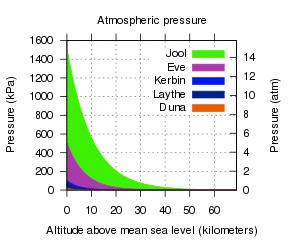Difference between revisions of "Atmosphere"
(Delete a whole bunch of outdated information.) |
m (Remove "outdated" tag.) |
||
| Line 1: | Line 1: | ||
| − | |||
| − | |||
[[File:Pressures.svg|thumb|The pressures for all atmospheres]] | [[File:Pressures.svg|thumb|The pressures for all atmospheres]] | ||
{| class="wikitable float-right" | {| class="wikitable float-right" | ||
Revision as of 23:26, 20 November 2015
| Planets | Moons | ||||
|---|---|---|---|---|---|
| |
Eve | |
Kerbin | |
Laythe |
| |
Duna | |
Jool | ||
The atmosphere of a celestial body slows the movement of any object passing through it, a force known as atmospheric drag (or simply drag). An atmosphere also allows for aerodynamic lift. The celestial bodies with atmospheres are the planets Eve, Kerbin, Duna and Jool, as well as Laythe, a moon of Jool. Only Kerbin and Laythe have atmospheres that contain oxygen and thus produce intake air for jet engines to work.
Atmospheric pressure diminishes exponentially with increasing altitude. An atmosphere's scale height is the distance over which atmospheric pressure changes as a factor of e, or 2.718. For example, Kerbin's atmosphere has a scale height of 5000 m, meaning the atmospheric pressure at altitude n is 2.718 times greater than the pressure at altitude n + 5000.
Atmospheres vary in temperature, though this has no bearing on gameplay.
Atmospheres allow aerobraking and easier landing. However, an atmosphere makes taking off from a planet more difficult and increases the minimum stable orbit altitude.
Contents
Drag
In the game, the force of atmospheric drag is dependent on the shape of a part and which of the part's attachment nodes are in use. (For example, nose cones reduce drag on the part to which they are attached.) A debug-mode option allows you to see the exact drag force on a given part by right-clicking on it.
The atmospheric density ρ is directly proportional to atmospheric pressure (p of unit atm), which is a function of altitude, the atmosphere's pressure at altitude 0 (p0), and scale height (H):
where p here is in units atm, and ρ in kg/m3. The conversion factor of 1.2230948554874 kg/(m3·atm) is given by FlightGlobals.getAtmDensity(1.0), which returns the density at 1 atmosphere (sea level on Kerbin) pressure.
Atmospheric height
The atmospheric height depends on the scale height of the celestial body and is where 0.000001th (0.0001%) of the surface pressure remains. Therefore, the atmospheric pressure at the edge of the atmosphere is relative; for example a craft in orbit around Jool can have a lower orbit (relative to the surface) because the surface pressure is higher.
To calculate the atmospheric heights of other celestial bodies:





